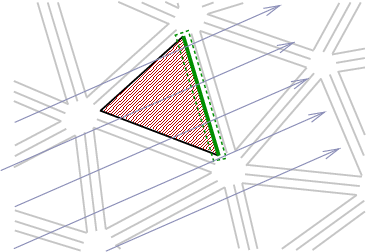This page was generated from unit-3.5-surfacehdg/surfacehdg.ipynb.
3.5 Scalar PDE on surfaces (with HDG)¶
We are solving the scalar linear transport problem
\[\partial_t u - \varepsilon \Delta_\Gamma u + \operatorname{div}_\Gamma ( \mathbf{w} u ) = 0 \quad \text{ on } \Gamma,\]
where \(\Gamma\) is a closed oriented surface in \(\mathbb{R}^3\).
[1]:
from ngsolve import *
import netgen.gui
from math import pi
Mesh of (only) the surface:¶
We consider the unit sphere (only surface mesh!)
[2]:
from netgen.csg import *
geo = CSGeometry()
geo.Add(Sphere(Pnt(0,0,0),1).bc("sphere"))
[2]:
0
[3]:
from netgen.meshing import MeshingParameters
from netgen.meshing import MeshingStep
mp = MeshingParameters(maxh=0.5, perfstepsend = MeshingStep.MESHSURFACE)
mesh = Mesh(geo.GenerateMesh(mp=mp))
[4]:
order = 4
if order > 0:
mesh.Curve(order)
Draw(mesh)
Tangential velocity field:¶
[5]:
t = Parameter(0.)
b = CoefficientFunction((y,-x,0))
Draw (b, mesh, "b")
eps = 5e-5
some local quantities¶
normal, tangential, co-normal and mesh size
[6]:
n = specialcf.normal(mesh.dim)
h = specialcf.mesh_size
local_tang = specialcf.tangential(mesh.dim)
con = Cross(n,local_tang) #co-normal pointing outside of a surface element
bn = InnerProduct(b,con)
Discretization¶
Surface FESpaces:¶
[7]:
fesl2 = SurfaceL2(mesh, order=order)
fesedge = FacetSurface(mesh, order=order)
fes = FESpace([fesl2,fesedge])
u,uE = fes.TrialFunction()
v,vE = fes.TestFunction()
surface gradients, co-normal derivatives and jumps:¶
[8]:
gradu = u.Trace().Deriv()
gradv = v.Trace().Deriv()
jumpu = u - uE
jumpv = v - vE
dudn = InnerProduct(gradu,con)
dvdn = InnerProduct(gradv,con)
Diffusion formulation (Hybrid Interior Penalty on Surface):¶
\[ \sum_T \int_T \nabla u \nabla v
- \sum_T \int_{\partial T} n \nabla u (v-\widehat v)
- \sum_T \int_{\partial T} n \nabla u (u-\widehat u)
+ \frac{\alpha p^2}{h} \sum_F \int_F (u-\widehat u)(v-\widehat v)\]
[9]:
a = BilinearForm(fes)
# diffusion
dr = ds(element_boundary=True)
alpha = 10*(order+1)**2
a += eps*gradu * gradv * ds
a += - eps*dudn * jumpv * dr
a += - eps*dvdn * jumpu * dr
a += eps*alpha/h * jumpu * jumpv * dr
Convection formulation (Hybrid Upwinding):¶
\[ \sum_T \int_T - u \mathbf{w} \cdot \nabla v
+ \sum_T \int_{\partial T} (\mathbf{w} \cdot \mathbf{n}) u^{hyb-upw} v
+ \sum_T \int_{\partial T_{out}} (\mathbf{w} \cdot \mathbf{n}) (\hat{u} - u) \hat{v}\]
with
\[\begin{split}u^{hyb-upw} = \left\{ \begin{array}{cll} u & \text{if } \mathbf{w} \cdot \mathbf{n} & (outflow), \\ \hat{u} & \text{else} & (inflow) . \end{array} \right.\end{split}\]
outflow |
inflow |
|---|---|
|
|
[10]:
a = BilinearForm(fes)
# convection (surface version of Egger+Schöberl formulation):
a += - u * InnerProduct(b,gradv) * ds
a += IfPos(bn, bn*u, bn*uE) * v * dr + IfPos(bn, bn, 0) * (uE - u) * vE * dr
a.Assemble()
[10]:
<ngsolve.comp.BilinearForm at 0x7f92b00ba8b0>
Mass matrix:¶
[11]:
m = BilinearForm(fes)
m += u*v*ds
m.Assemble()
[11]:
<ngsolve.comp.BilinearForm at 0x7f92b00bad70>
\(M^\ast\)-matrix for implicit Euler¶
[12]:
dt = 0.02
mstar = m.mat.CreateMatrix()
mstar.AsVector().data = m.mat.AsVector() + dt * a.mat.AsVector()
mstarinv = mstar.Inverse()
from math import pi
T = 8*pi
Time stepping¶
Visualization of solution (Deformation in normal direction)¶
[13]:
gfu = GridFunction(fes)
gfu.components[0].Set(1.5*exp(-20*(x*x+(y-1)**2+(z)**2)),definedon=mesh.Boundaries("sphere"))
Draw (gfu.components[0], mesh, "u")
Draw (gfu.components[0]*n, mesh, "un", sd=4, autoscale=False)
res = gfu.vec.CreateVector()
SetVisualization(deformation=True)
The time loop¶
[14]:
t.Set(0)
for i in range(int(T/dt)):
res.data = m.mat * gfu.vec
gfu.vec.data = mstarinv * res
Redraw(blocking=True)
t.Set(t.Get()+dt)
Remark:¶
We can apply static condensation as in the volume

